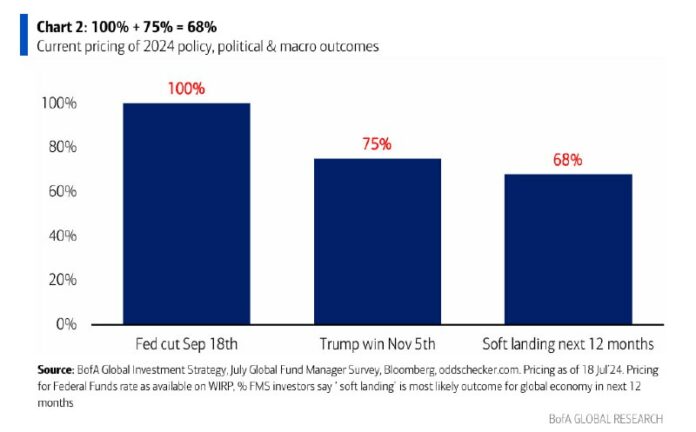“Buy the Rumor, Sell the Fact”
Here’s how Michael Hartnett is seeing things.
First, recall from about two months ago when the BofA strategist almost perfectly prophesized how the tech/Mag7 rally would, at the very least, begin to stall:
May 31: “next is value outperforming growth stocks + breadth reversing as economic growth slows… catalyst is a benign “
📝 “Breadth” refers to the number of stocks participating in a market movement, up or down. It’s been very weak in the first half of 2024 because Big Tech has dominated.
Lo and behold, that was exactly the catalyst we got on July 11th in the “cold” CPI print, and, instead of sending stocks surging as rate cuts get priced in (this is “buying the rumor”), now with 100% chance of rate cuts, the rally reversed into selling by the end of last week (this is “sell the fact”).
Then, we go to last week where Hartnett signaled what would be the ultimate recession catalyst, in certain terms, and how to tell the (widely expected) soft landing apart from a hard landing:
“if data confirms soft landing (limited deterioration in labor market, yields remain ~4%), this finally bullish for market breadth (leverage, value, EM and so on) but ‘sellers’ strike’ in mega-cap tech/AI won’t change…stocks sideways but breadth much better (although many cyclical sectors have discounted this outcome).“
“…if data confirms harder landing (unemployment rate moves toward 4.5%, payrolls trade much more straightforward asset allocation flip to bonds, from stocks, likely very painful selling in tech; we say market not sufficiently pricing in risk of harder landing.“
In his latest Flow Show from Friday, Hartnett summarizes the big picture: “investors bullishly assigning 100% probability of Fed rate cut Sept 18th, 75% probability of Trump winning US election Nov 5th, and 68% probability of ‘soft landing’…; Sept 18th/Nov 5th ‘buy rumor, sell fact’ dates…sell 1st rate cut still the call.“
Heading into these two catalysts (the first rate cut in September, and the election), Hartnett says that he is “bullish bonds, bullion, breadth (rotation to “poor” distressed value e.g. REITs, distressed growth e.g. biotech, not “middle class” sectors already priced for soft landing).“
But suggests selling the events as they will be widely expected and thus already priced in.
Hartnett concludes by taking a closer look at the top two Ps the matter: Politics and Policy.
On Politics, he writes that “investors fear US election sweep means inflationary higher tariffs, lower taxes, lower immigration, thus higher bond yields“, and yet the electoral reality is that to voters “inflation” is what matters most (how else to explain sub-40% Presidential approval rating with 4% unemployment rate).
Hartnett cites a recent study which found that 70% of young voters in key battleground states say “cost of living/inflation” most important issue and 2024 is the first election in 30 years in which Baby Boomers won’t be majority voting bloc: 65 million Gen Z & Millennial votes will outnumber 50 million boomers.
Electorate wants low inflation…which is bullish bonds (although the Trump presidency may have to go through a rather painful realization phase before figuring out that a hard landing is the one surefire way to neuter inflation).
On Policy: the irony is that those “much hated” 2018 Trump tariffs and trade war have been maintained/extended by Biden; yet Hartnett says new tariffs in the next 12 months more likely to be deflationary than inflationary because the “2018 trade war occurred with backdrop of strong global macro & low interest rates; 2024/25 backdrop for tariffs is much weaker.“
This means new tariffs threaten a weak global economy with recession (tax hikes on global economy + business uncertainty).
🔗 BofA (Hartnett)
It should also be said that Hartnett has remained in the ‘hard landing’ camp since at least September 2023: “Soft landing all the rage but ain’t a bond manager in the world with more than $150bn of AUM who doesn’t think there won’t be a hard landing.”
“Buy the Rumor, Sell the Fact” is a catchy phrase often used in the world of investing and trading. It refers to the phenomenon where investors buy assets based on speculation or rumors before an event occurs, only to sell them once the event actually takes place. This strategy is based on the idea that market sentiment tends to be more optimistic leading up to an event, causing prices to rise, but once the event is over and reality sets in, prices may fall as investors take profits.
One strategist who has been closely following market trends and predicting potential market movements is Michael Hartnett of BofA. In recent months, Hartnett has accurately forecasted shifts in the market, particularly in the tech sector. He predicted a stall in the tech/Mag7 rally due to economic growth slowing down, and this prediction came to fruition with a weak CPI print on July 11th leading to a reversal in the market rally.
Hartnett has also discussed the possibility of a soft landing versus a hard landing in the economy. A soft landing would see limited deterioration in the labor market and yields remaining around 4%, which would be bullish for market breadth. On the other hand, a hard landing with rising unemployment and weak job numbers could lead to a painful sell-off in tech stocks.
As investors look ahead to key events like the first rate cut in September and the upcoming US election, Hartnett advises caution. While investors may be bullish on certain assets like bonds and gold, it may be wise to sell off popular assets as these events approach, as they are already widely expected and priced in by the market.
Hartnett also delves into the intersection of politics and policy and how these factors can impact market sentiment. He notes that the electorate is concerned about inflation and the cost of living, which could influence policy decisions and market movements. Additionally, he suggests that new tariffs in the current economic climate could pose risks to the global economy, potentially leading to a recession.
In conclusion, “Buy the Rumor, Sell the Fact” is a strategy that investors can use to capitalize on market movements before and after key events. By paying attention to market trends, economic data, and political developments, investors can make informed decisions and potentially profit from market fluctuations. Michael Hartnett’s insights and analyses provide valuable perspectives for investors navigating the complexities of the current market landscape.

